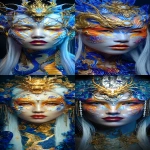Explore the Best AI Image Gallery

Beyond the Brush: How Edge Computing is Redefining Creative Expression
The creative landscape is undergoing a seismic shift, propelled by advancements in technology. Among these, edge computing stands out as a game-changer, empowering artists, designers, and innovators with unprecedented capabilities. By bringing computation closer to the source of data – be it sensors, devices, or users – edge computing unlocks new dimensions of creativity, enabling real-time interaction, immersive experiences, and collaborative workflows.
This blog post explores the profound impact of edge computing on the creative industry, delving into its potential applications, ethical considerations, and future trends.
Unlocking Creative Potential: Applications of Edge Computing
Edge computing is poised to revolutionize various facets of the creative process:
- Real-time Artistic Expression: Imagine an artist manipulating digital brushstrokes on a canvas that responds instantaneously to their movements, powered by edge computing. This eliminates latency issues, allowing for fluid and intuitive artistic creation.
- Immersive Experiences: Edge computing enables the development of highly immersive and interactive art installations. Visitors can interact with sculptures, paintings, or environments in real time, triggering dynamic changes based on their presence and actions.
- Personalized Creative Outputs: Edge-powered algorithms can analyze user preferences and generate personalized creative content, such as music compositions, artwork, or narratives tailored to individual tastes.
- Collaborative Creativity: Multiple users can collaborate on creative projects in real time, regardless of their geographical location. Edge computing facilitates seamless data sharing and synchronization, fostering a truly global creative community.
Navigating Ethical Considerations
As with any transformative technology, edge computing in the creative industry raises ethical considerations that require careful attention:
- Data Privacy and Security: Edge devices collect vast amounts of user data. Ensuring robust security measures and transparent data handling practices is paramount to protect user privacy.
- Bias and Fairness: Algorithms used in edge-powered creative tools can perpetuate existing biases if not carefully designed and monitored. Its crucial to strive for fairness and inclusivity in algorithmic development.
- Intellectual Property Rights: The ease of content generation through edge computing raises questions about intellectual property ownership. Clear guidelines and legal frameworks are needed to address these complexities.
- Accessibility and Inclusivity: Access to edge-powered creative tools should be equitable, ensuring that individuals with disabilities or limited resources can participate fully in the creative process.
Future Trends Shaping the Landscape
The future of edge computing in the creative industry is brimming with possibilities:
- Integration with Augmented and Virtual Reality: Edge computing will enhance immersive experiences by enabling real-time interactions within AR/VR environments, blurring the lines between the physical and digital realms.
- Democratization of Creative Tools: Edge computing will empower individuals with limited technical expertise to create compelling content, fostering a more inclusive and participatory creative ecosystem.
- Artificial Intelligence Collaboration: Edge-powered AI algorithms will collaborate with human creatives, augmenting their abilities and unlocking new levels of artistic expression.
- Sustainable Practices: Edge computing can contribute to sustainable creative practices by reducing energy consumption and minimizing the environmental impact of content creation and distribution.
The convergence of edge computing and creativity is poised to usher in a new era of artistic exploration and innovation. By embracing its potential while navigating ethical considerations, we can unlock a future where creativity knows no bounds.



](https://images.ai-img.art/thumbnails/150/269414b0e541026702e9e67c67602c96162f37ff460a388b3b36314c8fc936dd.webp)







](https://images.ai-img.art/thumbnails/150/3020b8c2b6d9be07e042357107af1de10deb274a41d2b0f332684ad4b532a702.webp)











](https://images.ai-img.art/thumbnails/150/8d1fe5a7a49cfc96747182431a853357913286d89258383caab2d3b4681afcb5.webp)








](https://images.ai-img.art/thumbnails/150/485c8b1c747827bdc9a962f8a1919b3c259b18dd263b260208a1eae19fb85e07.webp)





](https://images.ai-img.art/thumbnails/150/2fbd98ecfc425cfc1597779121e1c0305437067779e9c471eb64ff9615d5be98.webp)



](https://images.ai-img.art/thumbnails/150/5197af8969d850e2a43e141d41e482ccbceedebceb2a4caf9f098f943f9d1b0f.webp)






